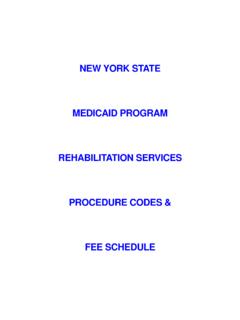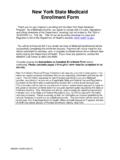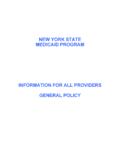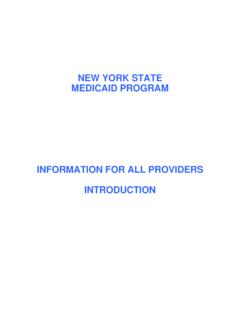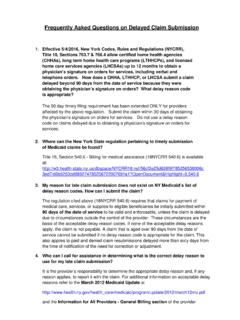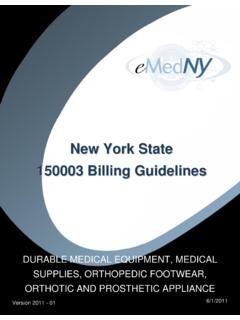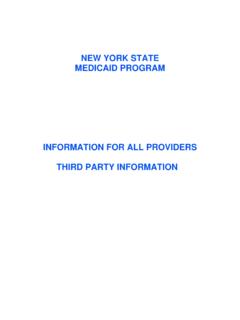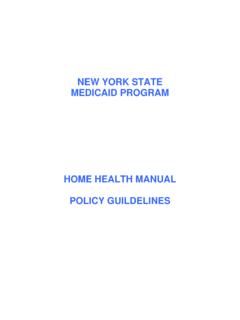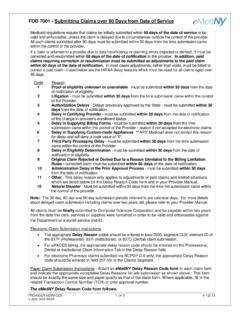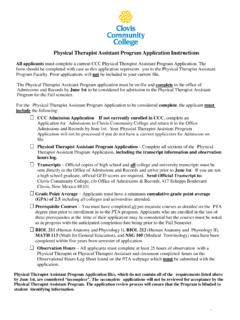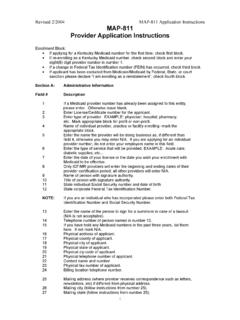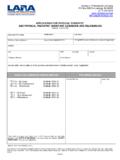Transcription of REHABILITATION SERVICES POLICY GUIDELINES - eMedNY
1 REHABILITATION SERVICES Manual POLICY GUIDELINES Version 2015 -1 Page 1 of 11 NEW YORK STATE MEDICAID PROGRAM REHABILITATION SERVICES POLICY GUIDELINES REHABILITATION SERVICES Manual POLICY GUIDELINES Version 2015 -1 Page 2 of 11 Table of Contents SECTION I REQUIREMENTS FOR PARTICIPATION IN 3 QUALIFIED 3 RECORD KEEPING REQUIREMENTS .. 3 WRITTEN ORDER 3 SECTION II 4 BENEFIT 4 DUPLICATE 4 4 LONG TERM THERAPY 5 5 PRIOR 5 QUALIFIED 6 6 REHABILITATION 7 RESTORATIVE 7 THERAPY 7 SECTION III COVERAGE 8 SECTION IV TREATMENT 9 SECTION V DOCUMENTATION 10 REHABILITATION SERVICES Manual POLICY GUIDELINES Version 2015 -1 Page 3 of 11 Section I - Requirements for Participation in Medicaid Qualified Practitioner Qualified Practitioner, for the purpose of this section, means a therapist who has passed the necessary national examination, obtained state licensure, and performs within the scope of licensure as regulated by federal and state governments and as defined by the appropriate professional organization (.)
2 American Physical Therapy Association (APTA), American Occupational Therapy Association (AOTA), and American Speech-Language-Hearing Association (ASHA)). Physical Therapy (PT) assistants or Occupational Therapy (OT) assistants may provide SERVICES under the direction and supervision of their respective Physical or Occupational therapist . Certified teachers of the speech and hearing handicapped (TSHH) or certified teachers of students with speech and language disabilities (TSSLD) employed by the federal, state or a local government or by a public or non-public elementary or secondary school or an institution of higher learning may provide speech therapy SERVICES under the direction of a qualified NYS licensed and currently registered speech-language pathologist in the course of such employment.
3 Aides, athletic trainers, exercise physiologists, life skills trainers, special education teachers, paraprofessionals, and REHABILITATION technicians do not meet the definition of a qualified practitioner regardless of the level of supervision. Record Keeping Requirements In addition to meeting the general record keeping requirements outlined in the General POLICY Section for all providers, the qualifying documentation should be done in accordance with the clinician s professional organization ( , APTA, AOTA, ASHA) standards. Written Order Requirements REHABILITATION SERVICES must be ordered, in writing, by a physician, physician assistant, or nurse practitioner so authorized by law. In addition, speech therapy SERVICES may be provided based on a written referral from a speech-language pathologist so authorized by law.
4 REHABILITATION SERVICES Manual POLICY GUIDELINES Version 2015 -1 Page 4 of 11 Section II - Definitions For the purposes of the Medicaid program and as used in this Manual, the following terms are defined to mean: Benefit Limit Certain beneficiaries are limited to 20 therapy visits per fiscal year for each type of therapy covered (physical, occupational, and speech therapy). The fiscal year begins April 1st and ends March 31st of the next year. Certain Medicaid enrollees, settings, and circumstances are exempt from the 20-visit limitation. These include: Children from birth to age 21 (until their 21st birthday) Recipients with a developmental disability (R/E code 95) Recipients with a traumatic brain injury (TBI) (waiver recipients R/E code 81, or any claim with a primary diagnosis code (850-854) for traumatic brain injury) Recipients with both Medicare Part B and Medicaid coverage (dually eligible enrollees) when Medicare Part B payment is approved REHABILITATION SERVICES received as a hospital inpatient Recipients receiving REHABILITATION SERVICES in a nursing home in which they reside REHABILITATION SERVICES provided by a certified home health agency (CHHA) Duplicate therapy The same therapy service(s) and/or treatment(s)
5 Provided by more than one therapy type ( , both Physical and Occupational Therapy, or both Occupational and Speech Therapy); OR the same discipline in different settings ( , School and Home based). Each specific discipline or same discipline in a different setting should, absent of unique circumstances documented in the medical record, have a unique and specific evaluation, treatment plan, goals, and therapeutic interventions. Evaluation An assessment of the beneficiary s physical and functional status used to determine if PT, OT, or ST SERVICES are medically necessary, gather baseline data including objective findings, and establish a treatment plan with reasonable and attainable goals within a defined period of time. Evaluations are administered with appropriate and relevant assessments using objective measures and/or tools.
6 An evaluation is required prior to implementing any treatment plan. REHABILITATION SERVICES Manual POLICY GUIDELINES Version 2015 -1 Page 5 of 11 Long Term Therapy SERVICES Physical, Occupational, and/or Speech therapy SERVICES , that due to a beneficiary s unique physical, cognitive or psychological status, require the knowledge or expertise of a licensed practitioner in order to maintain their physical and/or functional status. Outcomes must be functional, individualized, relevant, and transferrable to the current or anticipated environment. Therapeutic goals must meet at least one of the following characteristics: prevent deterioration and sustain function; provide interventions that enable the beneficiary to live at their highest level of independence in the case of a chronic or progressive disability; and/or provide treatment interventions for a beneficiary who is progressing, but not at a rate comparable to the expectations of restorative care.
7 Modifier Two-digit code used to further define or explain the nature of the procedure. The appropriate modifier, from Table 1, must be included on prior authorization requests and claims to identify the specific type of therapy. Table 1. Modifiers for REHABILITATION Procedures Modifier Description GP SERVICES delivered under an outpatient physical therapy plan of care. GO SERVICES delivered under an outpatient occupational therapy plan of care. GN SERVICES delivered under an outpatient speech-language pathology plan of care. Prior Authorization Prior authorizations allow tracking of the number of REHABILITATION visits per discipline an enrollee receives per benefit year. A prior authorization (PA) must be obtained for each therapy visit for enrollees not exempt from the 20-visit limitation (See Benefit Limit definition).
8 A unique prior authorization number must be obtained through the Dispensing Validation System (DVS) for each visit. Modifiers will be used to distinguish therapy types when requesting a DVS prior authorization number. A request for a prior authorization should be submitted before the provision of service. The request may be made after the date of the service and can be approved if the beneficiary has not already been authorized for 20 visits. A maximum of 20 prior authorization numbers will be issued for each therapy type. Further instructions on obtaining a DVS authorization REHABILITATION SERVICES Manual POLICY GUIDELINES Version 2015 -1 Page 6 of 11 number can be accessed online at: #MEVS/DVS Prior authorization does not ensure payment.
9 Even if a service has been prior authorized, the provider still must verify an enrollee s eligibility via the MEVS before rendering service and the claim must be otherwise payable in accordance with the requirements as found in each related section of the provider manual. NOTE: Providers do not need to get a PA for enrollees that are exempt from the benefit limit ( , R/E 95 and R/E 81 enrollees) or for REHABILITATION therapy provided in exempt settings ( , hospital inpatient), or for REHABILITATION SERVICES provided by a certified home health agency (CHHA). See Benefit Limit for more information. Qualified Practitioner A therapist who has passed the necessary national examination, obtained state licensure, and performs within the scope of licensure as regulated by federal and state governments and as defined by the appropriate professional organization ( , APTA, AOTA, ASHA).
10 Physical Therapy (PT) assistants or Occupational Therapy (OT) assistants may provide SERVICES under the direction and supervision of their respective Physical or Occupational therapist . Certified teachers of the speech and hearing handicapped (TSHH) or certified teachers of students with speech and language disabilities (TSSLD) employed by the federal, state or a local government or by a public or non-public elementary or secondary school or an institution of higher learning may provide speech therapy SERVICES under the direction of a qualified NYS licensed and currently registered speech-language pathologist in the course of such employment. Aides, athletic trainers, exercise physiologists, life skills trainers, special education teachers, paraprofessionals, and REHABILITATION technicians do not meet the definition of a qualified practitioner regardless of the level of supervision.

